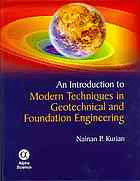Table Of ContentNNNNNaaaaaiiiiinnnnnaaaaannnnn PPPPP..... KKKKKuuuuurrrrriiiiiaaaaannnnn
α
Alpha Science International Ltd.
Oxford, U.K.
An Introduction to Modern Techniques in
Geotechnical and Foundation Engineering
384 pgs. | 382 figs. | 10 tbls.
Nainan P. Kurian Ph.D., D.Sc.,
Professor of Civil Engineering (Retd.)
Indian Institute of Technology, Madras
Chennai, India
Email: <[email protected]>
Copyright © 2013
ALPHA SCIENCE INTERNATIONAL LTD.
7200 The Quorum, Oxford Business Park North
Garsington Road, Oxford OX4 2JZ, U.K.
www.alphasci.com
All rights reserved. No part of this publication may be reproduced, stored in a retrieval system,
or transmitted in any form or by any means, electronic, mechanical, photocopying, recording
or otherwise, without prior written permission of the publisher.
Printed from the camera-ready copy provided by the Author.
ISBN 978-1-84265-790-4
Printed in India
Affectionatelydedicatedto
myfourgrandchildren
AshwiniMaryMathew,
ArunCherianMathew,
DiyaElizabethKurian,and
RayhanKoshyJohnKurian,
whosegenerationoughttogainby
thetechnologiesdescribedinthisbook.
Foreword
Thepastthreedecadeshaveseenaremarkableproliferationinthevolumeofliteraturedevotedtogeotech-
nicalandfoundationengineering.Therearenowavastnumberofjournalsthataddressthesesubjects,and
many conferences annually produce a welter of papers of variable quality. The undergraduate student is
insulatedfromthisplethoraofinformationbycurriculathatusuallyfollowawell-troddenpathandwhich
coverthebasicsofsoilmechanicsandengineeringmechanicsandwhichemploytextsthathavebeentried,
testedandrefinedoverthepast50years.
The new graduate that typically emerges from the academic cocoon into the real world of engineering
isconfrontedbymanyunfamiliarconceptsandchallenges, andifheorshebecomesinvolvedingeotech-
nical and foundation engineering, it may be a daunting task to retrieve relevant and reliable background
informationontheseconcepts,theinternet,GoogleandWikipedianotwithstanding.Seasonedprofessionals
may similarly face challenges in trying to find information on new techniques without delving into the
intricacies of journal and conference papers which, because of the limitations of publication space, are
oftencurtailedandover-succinct,andassumelevelsofknowledgewhichareuncommonoutsideacademic
circles.
It is for such groups that this new book, by a committed and passionate academic and author with
an abiding interest in the professional and practical aspects of geotechnical and foundation engineering,
Prof.NainanP.Kurian,willbeparticularlywelcome.Astheauthorstatesinhispreface,notallaspectsof
geotechnicalandfoundationengineeringcanbecoveredinasinglebook,buthedoesidentifyanumberof
importantareas,sometraditionalandsomemorerecent,onwhichtofocus.Foreachtopicthatheaddresses,
heprovidesacleardescription, asetofrelevantreferences, andmostimportantly, excellentdiagramsthat
accompanyandilluminatethetext.Theoldadageaboutapicturebeingworthathousandwordsiscertainly
operativeinthisbook.Insodoing,hehelpsthereadertoappreciatetheconceptsandunderlyingfundamentals
ofthetopic,withoutbecomingoverwhelmedbyequationsandmathematicalderivations.
The book covers a number of traditional areas, such as various foundation types, pile foundations, and
earth retaining structures, and while it tends to focus on the geotechnical aspects of foundations, it also
addresses the structural issues which are an integral part of the design process. The book also highlights,
among others, the author’s own contributions in areas such as ‘special piles’ (tapered piles, under-reamed
piles and screw piles) and ‘shell foundations’. The latter topic has been his major field of engagement in
hislongacademiccareer, culminatinginthefirstbookonthesubject. Thecurrentbookalsotreatsseveral
topics that appear infrequently, or not at all, even in contemporary texts. These include geosynthetics, a
numberofmoderngroundimprovementmethods(vacuumconsolidation,dynamicconsolidation,soilcrete),
piled raft foundations, drilling muds, and cathodic protection for foundations. The final chapter deals
with a number of interesting case histories, ranging from very recent cases such as the world’s current
tallest building, to one of the world’s oldest, and still enigmatic, group of structures, the pyramids of
Egypt.
Ihavelongheldtheviewthatourprofessionshouldoccasionallypauseandconsolidateexistingknow-
ledge,ratherthanproceedheadlongwithresearchintoareasofdiminishingintellectualandpracticalreturn.
Dr.NainanKurian’sbookisanimportantcontributiontothisconsolidationofknowledge.Itisabookthat
deservestobereadwidelybypracticingprofessionalsinvolvedingeotechnicalandfoundationengineering,
viii Foreword
but also one that should be made available to undergraduate and graduate students so that they can better
appreciatethecontextinwhich,andthelimitationsof,theiroften-complexcomputeranalysesareundertaken.
Importantly, the geotechnical communities in developing countries will stand to benefit by adopting, and
perhapsadapting,thenewtechnologiesdescribedinthisbook.
Sydney, ProfessorHarryG.Poulos
October2012 AM,BE,PhD,DScEng
FIEAust,FASCE,M.ACEA,FAA,FTSE
CoffeyGeotechnicsandUniversityofSydney
Australia
Preface
This book is essentially an outgrowth of Part II of the author’s earlier book ‘Modern Foundations –
AnIntroductiontoAdvancedTechniques’∗(PartIofthisbookcoveringthesubjectofshellfoundationshas
alreadyappearedasaseparatetreatiseunderthetitle‘ShellFoundations–Geometry,Analysis,Designand
Construction.’∗∗) Quite a substantial body of material has been added to the same to make the treatment
as current as possible, much as the author is keenly aware of the fact the title is too ambitious to make
suchaclaimeverremainingfulfilledinafastgrowing, technology-drivensubjectasmoderngeotechnical
and foundation engineering. A further word may be appropriate at this stage itself as regards the title of
thebook.Eventhoughfoundationengineering–especiallyitsgeotechnicalcomponent–isverymuchpart
of geotechnical engineering, it has a strong structural component, which hopefully justifies its individual
mentioninthetitle.
Following from what has been stated above, no claim is made to comprehensiveness, depth or being
up-to-date in coverage; indeed, as mentioned, no book under a title of the present kind can ever claim
to be so. When it comes to a book, however, one should feel contented at the possibility of timely new
editionswhichmaymercifullyremedythissituation. Asregardsthepresentcontents, thebookprovidesa
compendiumofkeyreferences,whichshouldenabletheinquisitivereadertopursuehisindividualinterest
fromsuchabase.
Apublicationofthistypeattemptingtosurveymoderndevelopmentsinavastsubjectarea,isbesetwith
morelimitationsthanwhathasbeenhintedatbefore. Besideseverythingelse, itislimitedbytheauthor’s
own knowledge of developments in the subject, derived from reading and observations which may have
severalgapsandcanbesignificantlyfarfrombeingexhaustive.
A very vulnerable aspect indeed is the order of presentation which cannot compete with the same in a
textbook, wheretheordertakesmoreorlessaprescribedcourse. Theassortednatureoftopicscoveredin
thisbook,spanningtheentiregamutofgeotechnicalengineeringandfoundationengineering,thelatterwith
structuralovertones,defiesanorganisationandorderofpresentationonmorelogicalandrationallinesthan
whathasbeenattemptedhere.
Authorslikemewhoarestronglyconvincedoftheever-present,ever-expandingandnever-endingneed
for improving and enhancing the quality of technical communication, would lament the lack of powerful
media such as video, which can explain and illustrate far more efficiently and effectively than the printed
word,thefunctioningofnewtechnologies,e.g.theplugformationinunder-mudconcreting,protectingthe
fresh concrete below, and the rising plug wiping off the mud-coating on the reinforcement. Such media
wouldinstructnotonlythestudents,butalsooldprofessionals,enablingthelattertotaketechnicallymore
informeddecisions.(Theexampleofthedrillingmudisquotedherebecausetheauthorhasheardofasenior
chief engineer for whom it is nothing but dirt and mud which would only ‘spoil’ the concrete, and if he
thoughtso,heisindeednottoblameforit!)Thesevideoscanillustratethetheoryinthefirstplace,followed
byclippingsfromfieldexamples.Theysupplementthecommunicativevalueofthewrittenwordandcanbe
∗Tata-McGrawHill,NewDelhi,1982
∗∗NarosaPubl.House,NewDelhi,2006
x Preface
attachedtobookssuchasthepresentone.(Theauthor’sbook‘DesignofFoundationsSystems–Principle
andPractices’# carriesadetaileddesignsoftwareonaCDwhichplaysasimilarsupplementaryrole.)
Whileonthetopicofsupplementingthewrittenword,theauthorfeelsitwouldbemostidealtodevelop
animation videos – leveraging the fast-growing field of ‘animation technologies’ which is making giant
stridesinthecomputerworld–toillustrateprinciples(e.g. waterpressure>earthpressure)whichwould
conveythetechnicalprinciplefarmoreeffectivelybycreatingthenecessary‘feel’forthetopic,whichevery
student must acquire. Fields such as ‘dynamic pile testing’ are ripe with these possibilities. (The author
hopestoinvolvehimselfinsuchanexerciseinthefuture,withaviewtoproducingthematerialonCDtobe
attachedtoafutureeditionofthisandhisearlierbooks.)
Thereisnodoubtthat‘knowing’isaprerequisitefor‘doing.’Thisbookisprimarilyaddressedtostudents
and professional communities in geotechnical engineering in the developing countries to instruct them
on what is relatively new in their field of activity. Developing countries will find themselves in the path
of development by imbibing and adapting new relevant technologies from the developed countries of the
world,besidesdevelopingtheirownappropriatetechnologiessuitingtheirdevelopmentalneeds.Theauthor
hopes that professional communities in the developed countries will also find the book useful to varying
degreesdependingupontheirbackgrounds.Theeventualbottomlineisdevelopmenttotheextentwhatthese
technologiescancontributetoit.
Sincethebookismeantforstudentsatvariousstagesoftheirstudies,andprofessionalsatvariouslevels
ofaccomplishments,aconsciousattempthasbeenmadetopresentthetopicsina‘graded’form–theinitial
partbeingmeantforundergraduateandpostgraduatestudentsandthesucceedingandfinalpartsforadvanced
professionals.Theauthorsincerelyhopesthattheusercommunitywillfindthisawelcomefeature.Research
scholarsareexpectedtofindthetopicspresentedasafertilefieldfordevelopingnewideasandorienttheir
researchinthosedirections.Arelatedfactoristhatsomeofthereferenceslistedgobeyondwhathasbeen
citedinthetext,whichtheadvancedreadermaybeinterestedinpursuing.Summingup,theauthorwould
likehiseffortstobeconsideredas‘teaching-at-large,’inanacademicsense.
TheauthorhastothankmanyinthepreparationofthisbookandthatincludestheChancellorandother
academic authorities of Karunya University, near Coimbatore, for permitting him the ‘extravaganza’ as it
were,whichsawthroughapartofthewritingofthisbookduringthecourseofhispart-timeemploymentas
visitingprofessorattheUniversity.AspecialwordofthanksisduetoDr.C.Gajendran,hisformercolleague
atKarunya,foralltheassistancerenderedbyhiminthecomputer-relatedworkpertainingtotypesettingthe
text.
The author is indeed thankful to his parent institution, the Indian Institute of Technology, Madras, for
thefinancialassistancegrantedforpreparingthemanuscriptinthecamera-readyform,asinthecaseofhis
earliertwobooks,undertheInstitution’sschemeofassistanceforbookwriting.Awordofthanksisalsodue
totheP.S.G.CollegeofTechnology,Coimbatore,wherehehadabriefstintasanEmeritusProfessorunder
theAllIndiaCouncilforTechnicalEducation.
The author wishes to place on record his deep sense of gratitude to Professor Harry G. Poulose, the
internationally acclaimed academic, author and consultant from Australia, for gracing this book with his
Foreword.Hiswordsreflecthisownenthusiasmforthetopicscoveredinthebookandendorsetheauthor’s
viewsontheneedforpresentingtheminthetechnologicalscenarioexistingacrosscountriesinthedeveloping
world.
TheauthortakesgreatpleasureinacknowledgingtheeffortsofhissonMr.RanjitP.Kurian,whoworked
as a senior software engineer in Microsoft Corporation at their headquarters in Redmond (near Seattle,
WashingtonState),U.S.A.,forscanningandconvertingprintedtextandpdffilesintoworddocuments,and
#NarosaPubl.House,NewDelhi,2005

